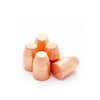Solid? We can define "Solid" technically as a bullet made of one material such as an all brass or all copper solid would be common. But for our discussion here, we will also talk about Full Metal Jacketed bullets as well, and maybe even some plain old cast bullets, which would be technically a solid as well...... There are Solid Trauma inflicting bullets as well, such as the Lehigh Extremes, but for this discussion we are going to limit it to Deep and straight line stable penetration, or deep diving solids........
In my world a properly designed "Solid" is used for maximum straight line penetration for large dangerous game, primarily for Elephant, hippo and buffalo, used in large bore rifle cartridges. Most all of the Factors of Solid Terminal Penetration for Rifle Bullets, also apply to Solid Handgun Bullets. The big difference between Rifle Solids and Handgun Solids is depth of penetration, it is common for properly designed rifle solids to penetrate my test medium from 50-70 inches of straight line, stable penetration, dependent upon the 8 known factors of Terminal Solid Performance. With a handgun it is vastly less, in a 45 ACP or 9mm a properly designed solid, and even less than desirable RN solids will only penetrate from 9-12 inches in the same medium. Larger capacity cartridges, such as 45 Colt or larger will go to 25 inches +...... regardless, much less than what a big bore rifle bullet can accomplish. Now keep this in mind, for any comparison to animal tissue, the test medium has to be "Aqueous".... I have used for 25 years a combination of wet news print and every 10 inches a 1.5 inch layer of magazine material. The magazine material adds about 30% to the density of the medium. This medium is far more dense than Ballistic Gel and will give much less depth of penetration. You would be hard pressed to test rifle solids in Ballistic Gel simply because of the amount you would have to have. Over many hundreds of animals taken a basic rule of thumb that I have worked out is that with Solids one will get on average about 35% more depth of penetration in animal tissue than my test medium here. Testing in anything that is not "aqueous" really has no bearing or meaning, since animals are aqueous, and not made up of dry materials.
This first post will only be an introduction to the topic of the discussion. In each post thereafter we will look at the specifics of Handgun Solid Penetration, and how they relate to what we KNOW for a fact about Rifle Solid Penetration. Below are the 8 Factors of Solid Terminal Performance........ Related directly to Rifle Solids. And they are in order of Importance.
My Plan will be to study the following;
45 ACP
9mm
45 Colt/454
Factors Involving Solid Straight Line Penetration & Depth of Penetration
#1 Meplat Percentage of Caliber
#2 Nose Profile
#3 Construction & Material
#4 Nose Projection
#5 Radius Edge of Meplat
Above Factors are in Bullet Design
#6 Velocity
#7 Barrel Twist Rate
#8 Sectional Density
In my world a properly designed "Solid" is used for maximum straight line penetration for large dangerous game, primarily for Elephant, hippo and buffalo, used in large bore rifle cartridges. Most all of the Factors of Solid Terminal Penetration for Rifle Bullets, also apply to Solid Handgun Bullets. The big difference between Rifle Solids and Handgun Solids is depth of penetration, it is common for properly designed rifle solids to penetrate my test medium from 50-70 inches of straight line, stable penetration, dependent upon the 8 known factors of Terminal Solid Performance. With a handgun it is vastly less, in a 45 ACP or 9mm a properly designed solid, and even less than desirable RN solids will only penetrate from 9-12 inches in the same medium. Larger capacity cartridges, such as 45 Colt or larger will go to 25 inches +...... regardless, much less than what a big bore rifle bullet can accomplish. Now keep this in mind, for any comparison to animal tissue, the test medium has to be "Aqueous".... I have used for 25 years a combination of wet news print and every 10 inches a 1.5 inch layer of magazine material. The magazine material adds about 30% to the density of the medium. This medium is far more dense than Ballistic Gel and will give much less depth of penetration. You would be hard pressed to test rifle solids in Ballistic Gel simply because of the amount you would have to have. Over many hundreds of animals taken a basic rule of thumb that I have worked out is that with Solids one will get on average about 35% more depth of penetration in animal tissue than my test medium here. Testing in anything that is not "aqueous" really has no bearing or meaning, since animals are aqueous, and not made up of dry materials.
This first post will only be an introduction to the topic of the discussion. In each post thereafter we will look at the specifics of Handgun Solid Penetration, and how they relate to what we KNOW for a fact about Rifle Solid Penetration. Below are the 8 Factors of Solid Terminal Performance........ Related directly to Rifle Solids. And they are in order of Importance.
My Plan will be to study the following;
45 ACP
9mm
45 Colt/454
Factors Involving Solid Straight Line Penetration & Depth of Penetration
#1 Meplat Percentage of Caliber
#2 Nose Profile
#3 Construction & Material
#4 Nose Projection
#5 Radius Edge of Meplat
Above Factors are in Bullet Design
#6 Velocity
#7 Barrel Twist Rate
#8 Sectional Density















































